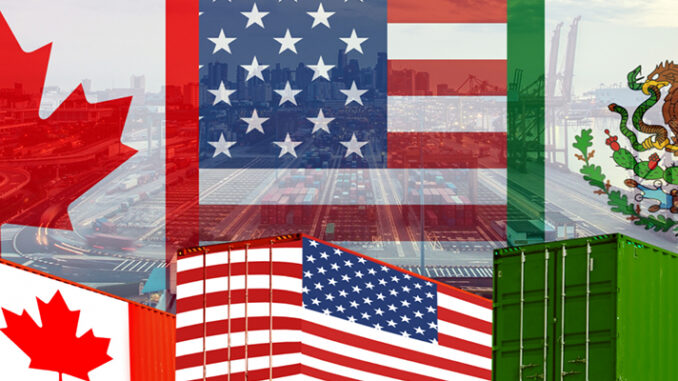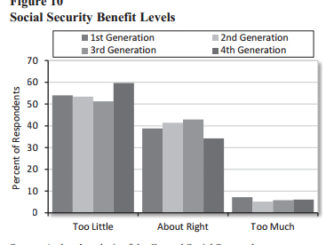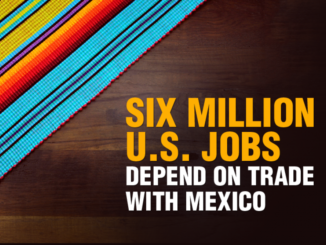
The Economist
Two books show that the forces driving the countries together are too strong to resist.
Vanishing Frontiers: The Forces Driving Mexico and the United States Together. By Andrew Selee. PublicAffairs; 336 pages; $28.
Homelands: Four Friends, Two Countries and the Fate of the Great Mexican-American Migration. By Alfredo Corchado. Bloomsbury Publishing; 304 pages; $27.
On the Mexican-American border in Tijuana stands a building that resembles the hull of a ship. In 2004 authorities discovered a tunnel that gangsters had dug inside it, to smuggle drugs beneath the border wall. Officials jammed the tunnel with concrete; the building was taken over by a cross-border arts council, which aims to promote cultural integration between Mexico and America. These days La Casa del Túnel hosts exhibitions and workshops for aspiring artists. Among the paintings that adorn the walls is a diptych of Adolf Hitler and Donald Trump.
Up on the roof, with its view across the border and into southern California, Tito Arveola is building the gallery’s café. Walls have sprung up throughout his life, Mr Arveola observes, yet the two countries have only grown closer. As a child in the 1970s he would cross the border without papers to carry bags for Mexicans buying groceries in American stores. Later he spent three decades in America legally, cleaning cars for a living. His current place of work embodies a neighbourly bond that is tightening even as politics becomes more vituperative. This process is the subject of new books by Alfredo Corchado, a Mexican-American journalist, and Andrew Selee, president of the Migration Policy Institute, a think-tank in Washington.
Mr Trump wants the wall to rise higher and stretch farther across the 3,145km frontier. He won the White House by telling voters that Mexico was sending its “worst” people, and that trade between the two countries was unfair to American workers. Many expected his victory to lead to a fundamental change in relations. Yet in 2017 bilateral trade increased. Security co-operation continues. In “Vanishing Frontiers”, Mr Selee argues that the relationship will deepen further.
Homes are where the heart is.
Beginning with the sister cities of Tijuana and San Diego, “Vanishing Frontiers” is an account of the people and places at the forefront of this integration. As Mr Selee reports, the two cities plan their futures together; their mayors talk of governing a single urban region. A new privately funded bridge, which crosses the wall and allows San Diegans to walk straight into Tijuana Airport, is a striking symbol of collaboration. The practical difficulties of sharing a border persist, but the underlying economic forces binding the countries together are irresistible.
American companies in search of cheap, diligent labour attract poor Mexican migrants or erect factories in Mexico. Products are increasingly made in both countries, with some zipping across the border several times along the way. In Tijuana the benefits are mutual: once a hub for factories with unskilled labourers, it now boasts many educated workers with sophisticated jobs. Meanwhile, security agencies work together to counter a drug racket that subsists on American demand and respects no boundaries.
Mr Selee’s book shows that what Mr Trump characterises as a zero-sum game is in fact a win-win arrangement. At La Casa del Túnel, that is Mr Arveola’s conclusion, too. He thinks Mexicans change when they cross the border. The same people who drop litter on the streets of Tijuana refrain from doing so in San Diego, he says. Though Americans come to Tijuana for beaches and bars at weekends, on weekdays the roads are full of Mexicans heading north for jobs. “You can tell it is a good thing to work in America, the cars are all nice models,” Mr Arveola notes.
In this tale of strengthening ties, the border-hoppers are the main protagonists. The number in America grew from 3m in 1962 to 36m today. Whereas Mexican men once went north for seasonal farm work before returning home, now whole families arrive and put down roots. The remittances they send home enrich some of Mexico’s poorest places. At the same time their dispersal beyond the border states means that much of America has become familiar with Mexican culture. But their visibility has also fuelled the nativist backlash that helped elect Mr Trump.
Mr Corchado, a journalist at the Dallas Morning News, has lived this story. In “Homelands” he recounts his experiences and those of three friends—altogether, three Mexicans and an American of Mexican descent—as they grapple with having two countries to call home. The book begins in Philadelphia, where the friends met, in the 1980s (back when no good tequila was imported). It eloquently chronicles the effects of the North American Free-Trade Agreement between Mexico, America and Canada, the militarisation of the border after the attacks of September 11th 2001 and Mr Trump’s victory.
In the early 1990s, when he lived in El Paso, Texas, and wrote a weekly column about trade, Mr Corchado was recognised at the drive-through window of a fast-food chain. “Is it true free trade will rescue us from these shitty jobs?” asked the attendant who handed over his meal. Twenty-five years later, El Paso has been transformed by new highways and bridges, and has a newfound sense of relevance. Since 1994 unemployment in the city has fallen by half. Yet in Mexico, beyond the border region, politicians’ predictions about NAFTA’s dividends have proved less accurate. Despite progress in places like Tijuana, overall wages have barely budged; disillusioned Mexican voters are about to elect a populist president of their own.
The decades-long wave of migration that Mr Corchado documents has now largely abated. But it has made Mexican-American relations more intimate. Family ties improved Mexicans’ views of their neighbour (though attitudes have been damaged by Mr Trump). One American in nine is now of Mexican origin, and companies from Netflix to NASCAR are courting them. So are Mexican firms which peddle the comforts of home. Mexican customs have duly found broader followings—not just tacos and soccer but also drinkable yogurt and pay-as-you-go phone contracts, a Mexican habit. Cultural influences run the other way, too. The children of Mexican migrants prefer English to Spanish, American music to Mexican and—increasingly—Protestantism to Catholicism.
At La Casa del Túnel, Mr Arveola confides that he was deported back to Mexico in 2002. “I screwed up,” he says, adding that, in America, small infractions can lead to deportation. Every morning, perched on the gallery’s roof, he watches illegal immigrants jumping the border fence below. Personally he is now content to live in Tijuana, where he has a wife and young daughter, and feels no need to return to America. Still, he would like to obtain a visa for his child, so she can visit her half-dozen aunts and uncles in California.
She will get her first English lessons when she starts school later this year, Mr Arveola says. He wants her to be fluent in both cultures (and to understand their differences). Her American name, Hannah, is a testament to his hopes.



